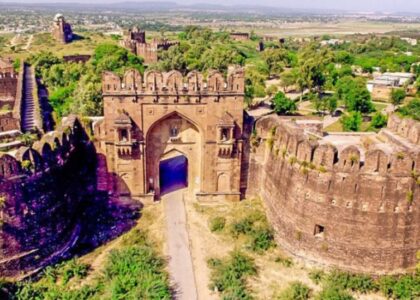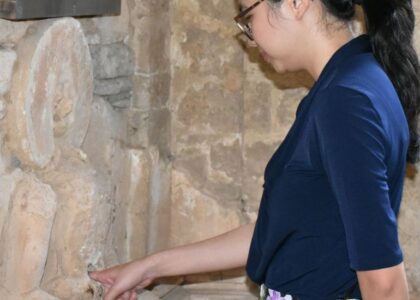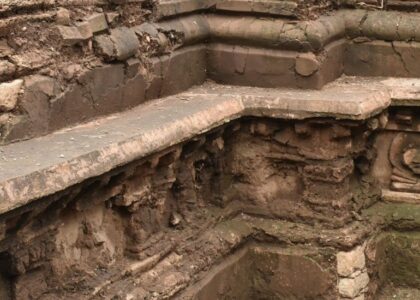Unveiling the Hidden Marvels of Rohtas Fort
Rohtas Fort, a testament to the ages, stands proudly near the city of Dina in the Jhelum district of Pakistan’s Punjab province. This fortress, known as Qila Rohtas in local languages, is more than just a collection of stones; it’s a window into the past, a symbol of power, and a living heritage that continues to captivate travelers from around the world.
Frequently Asked Questions
Question: Can we visit Rohtas Fort on Sundays?
Answer: Yes, you can visit Rohtas Fort on Sundays as it remains open for visitors.
What are the Opening and Closing Hours / Timings of Rohtas Fort?
Sunday 8 am–6:30 pm
Monday 8 am–6:30 pm
Tuesday 8 am–6:30 pm
Wednesday 8 am–6:30 pm
Thursday 8 am–6:30 pm
Friday 8 am–6:30 pm
Saturday 8 am–6:30 pm
Question : What is the Address and Location of Rohtas Fort?
Rohtas fort, Dina, Jhelum, Punjab 49400
Question: Do they charge an entry fee on Sundays at Rohtas Fort?
Answer: Yes, there might be an entry fee at Rohtas Fort. Please check with the authorities for the latest information. Currently they are charging an entry fee of 20 rupees to visit Rohtas Fort.
Question: Are there any special events or activities at Rohtas Fort?
Answer: Rohtas Fort might occasionally host special events or activities , so it’s a good idea to check for any announcements.
Question: Can we enjoy a guided tour at Rohtas Fort?
Answer: Yes, guided tours might be available at Rohtas Fort, offering insights into its historical significance.
Question: Is Rohtas Fort crowded?
Answer: Rohtas Fort may witness a moderate number of visitors, especially during peak tourist seasons.
Question: Is photography allowed at Rohtas Fort?
Answer: Yes, photography is usually allowed at Rohtas Fort. However, it’s advisable to follow the guidelines.
Question: Can we have a picnic at Rohtas Fort ?
Answer: While you might not be able to have a picnic inside the fort premises, you can enjoy its historical ambiance.
Question: Can we explore the entire fort in one Day?
Answer: While you might not be able to explore every nook and corner, you can certainly enjoy a substantial part of Rohtas Fort.
Question: Is there any specific dress code to follow Rohtas Fort?
Answer: While there might not be a strict dress code, it’s advisable to dress modestly and comfortably when visiting Rohtas Fort.
Question: Can we find refreshments or food options at Rohtas Fort?
Answer: While there might not be extensive food options, you can usually find basic refreshments at Rohtas Fort.
Question: Can we buy souvenirs or gifts on Sundays at Rohtas Fort?
Answer: There might be souvenir shops or stalls open at Rohtas Fort where you can purchase mementos.
Question: Are there any age restrictions for visiting Rohtas Fort ?
Answer: Generally, there are no specific age restrictions for visiting Rohtas Fort on Sundays. It’s open to visitors of all ages.
“Through our camera, Rohtas Fort becomes a symphony of past and present, where echoes of history harmonize with the click of a shutter.”
Safdar & Qasim

People Also AsK
What makes Rohtas Fort special? Rohtas Fort stands out for its robust defensive walls and monumental gateways. UNESCO recognized its exceptional representation of Muslim military architecture from Central and South Asia, inducting it as a World Heritage Site in 1997.
Who was responsible for constructing Rohtas Fort and where is it located? After defeating Mughal Emperor Humayun in 1541, Sher Shah Suri ordered the construction of Rohtas Fort at a strategic location near the city of Jhelum in Punjab, Pakistan. This imposing fortification sits on the historic GT road, connecting Afghanistan’s mountainous region to Punjab’s plains. Spanning around 4 km, it showcases the architectural prowess of the Afghan king.
What is the historical background of Rohtas Fort in Jhelum? Regarded as one of Pakistan’s most renowned historical sites, Rohtas Fort’s construction commenced in 1541. Guided by Todar Mal Khatri, revenue minister of Sher Shah Suri, the fort took seven years to complete, concluding in 1548.
Which fortress is considered the grandest in Pakistan? Known as the “Great Wall of Sindh,” Ranikot Fort holds the title of the world’s largest fort, encompassing a staggering circumference of approximately 32 kilometers.
Who emerged victorious in the Battle of Rohtas? The Battle of Rohtas in 1779 concluded with a triumph for the Durrani Empire, securing control over Rohtas Fort.
What was Rohtas district formerly known as? Originally a part of Shahabad District, Rohtas district in Bihar came into existence in 1972 when Shahabad District was split into Bhojpur and Rohtas. This district now belongs to the Patna division.
Which river is Rohtas Fort situated near? Rohtas Fort is perched on a hill within the Tilla Jogian Range, overlooking the confluence of the Kahān River and a seasonal stream named Parnal Khas. The elevation of the fort is approximately 91.5 meters above its surroundings.
What is the historical evolution of Rohtas district? Rohtas district’s historical roots trace back to the Magadh Empire, with notable influence during the pre-Mauryan era until the 5th century A.D. Emperor Ashok’s minor rock edict near Sasaram underscores the Mauryan conquests in the region.
What does “Rohtas Fort” signify? Rohtas Fort, also known as “Qila Rohtas” in Urdu, was constructed by Afghan king Sher Shah Suri. Spanning about 4 km, it is an architectural fusion of Pukhtun and Hindu styles, symbolizing successful amalgamation in the subcontinent.
When was Rohtas district established? Rohtas district came into existence in 1972, originating from the division of the former Shahabad district into Sasaram and Bhabua. Eventually, Bhabua became a distinct district, later renamed Kaimur in 1994.
Who was the mastermind behind Rohtas Fort’s creation? Rohtas Fort, a historically significant defensive structure, was commissioned by the renowned conqueror Sher Shah Suri. It was designed to withstand attacks from the Mughals, leading to their defeat and Emperor Humayun’s exile to Persia.
“Rohtas Fort’s architecture echoes the audacity of Sher Shah Suri’s vision and the artistry of the craftsmen.”
Safdar & Qasim
A Glimpse into History: Rohtas Fort’s Roots
At the helm of this architectural marvel was Raja Todar Mal, the minister of the Afghan king Sher Shah Suri. Dating back to the 16th century, this imposing fort was envisioned to be an embodiment of strength and strategic significance. Standing as one of the largest and most formidable fortresses in Punjab, Rohtas Fort has witnessed the tides of history and held its ground against the test of time.
A UNESCO Gem: Rohtas Fort’s Remarkable Preservation
The echoes of history reverberate through the remarkably intact walls of Rohtas Fort. In recognition of its historical importance, UNESCO bestowed the title of a World Heritage Site upon this extraordinary citadel in 1997. The fort’s unique blend of Central and South Asian Muslim military architecture earned it this prestigious accolade.
Where Beauty Meets Location: Discovering the Setting
Rohtas Fort occupies a breathtaking spot, nestled within the Tilla Jogian Range. The fortress stands sentinel over a gorge where the Kahān River merges with the seasonal stream, Parnal Khas. Its strategic position, elevated 91.5 meters above its surroundings, not only provided an advantageous vantage point but also created a masterpiece in harmony with its environment.
A Chronicle of Eras: Rohtas Fort Through Time
Sur Period: Sher Shah Suri, the founder of the Sur Empire, laid the foundation of Rohtas Fort as a strategic response to the resistance of the Gakhar tribe. This fortification, standing as a barrier between Afghanistan’s mountains and Punjab’s plains, played a pivotal role in shaping the course of history. Interestingly, the fort’s name celebrated Sher Shah Suri’s triumph over the Rohtas Fort in Bihar, India.
Mughal Period: With the passing of eras, the fort transitioned from a military stronghold to an administrative center. Its significance waned, and even emperors like Akbar found the nearby Attock Fort more aligned with their interests. Yet, Rohtas Fort remained a piece of history, hosting notable figures like Emperor Jahangir.
Sikh Empire: The fort continued its journey through time, witnessing the rise and fall of empires. Gurmukh Singh Lamba’s capture of the fort in 1825 marked a new chapter, followed by the Sikh Empire’s utilization of the fort for administrative purposes.
Architecture: The Canvas of Rohtas Fort
Layout: Rohtas Fort’s designers prioritized function over form, resulting in a structure that draws inspiration from Turkish, Middle Eastern, and South Asian artistic traditions. The sprawling fort spans 70 hectares, enclosed by 4 kilometers of walls. Its irregular triangular shape aligns with the contours of the hill, offering a glimpse into the minds of its creators.
Ramparts: The walls of Rohtas Fort, built with sandstone and lime mortar, stand tall, reaching heights of 10 to 18 meters. These fortified walls boast 68 bastion towers, each strategically positioned for defense. The ramparts gracefully follow the hill’s undulations, a testament to architectural ingenuity.
“In the heart of Rohtas Fort, stories are etched not just in stone, but in the spirit of a nation.”
Safdar & Qasim
Gates: Guardians of History
Rohtas Fort’s gates are not just entryways; they are portals to the past, each with its unique tale.
- Sohail Gate: This ceremonial gateway, adorned with ornamental floral motifs, captures the essence of the Sur Empire’s architectural finesse.
- Shah Chandwali Gate: Connecting the citadel to the main fort, this gate bears the memory of its namesake, Shah Chandwali, who left an indelible mark on its construction.
- Kabuli Gate: Facing Afghanistan’s Kabul, this gate has transformed into a center of information and a museum, embracing a new role in the modern era.
- Shishi Gate: The enchanting glazed tiles of Shishi Gate’s outer arch captivate visitors, offering a glimpse into the craft and creativity of the past.
- And More: The gates, from Gatali to Langar Khani, each tell a story of their own, beckoning travelers to step through time.
Rohtas Fort’s Legacy and Preservation
Rohtas Fort’s journey continues with the legacy it leaves behind. Recognized as a World Heritage Site, this fortress stands as a bridge between cultures and generations. The efforts of the Himalayan Wildlife Foundation, in collaboration with the Royal Norwegian Embassy, echo the sentiment of preservation and respect for this historical gem. The foundation’s Rohtas Fort Conservation Programme is a testament to the commitment of safeguarding history for generations to come.
A Glimpse into the Past, a Step into the Future
Rohtas Fort is more than just an architectural marvel; it’s a time capsule that transports visitors into the annals of history. With every step within its walls, one can’t help but feel a connection to the countless stories that have unfolded within its embrace. As the sun sets over Rohtas Fort, it stands as a silent guardian of the past, inviting travelers to explore, learn, and leave their own mark on the pages of its ongoing legacy.
Rohtas Fort’s history spans the Sur and Mughal periods, the Sikh Empire, and beyond, making it a fascinating destination for travelers seeking to uncover the layers of Pakistan’s past. With its impressive architecture, captivating gates, and cultural significance, Rohtas Fort offers a unique opportunity to step back in time while enjoying the splendor of its well-preserved beauty. Whether you’re a history enthusiast, an architecture lover, or simply a traveler with a taste for the extraordinary, Rohtas Fort promises an unforgettable journey through centuries of history and heritage.






